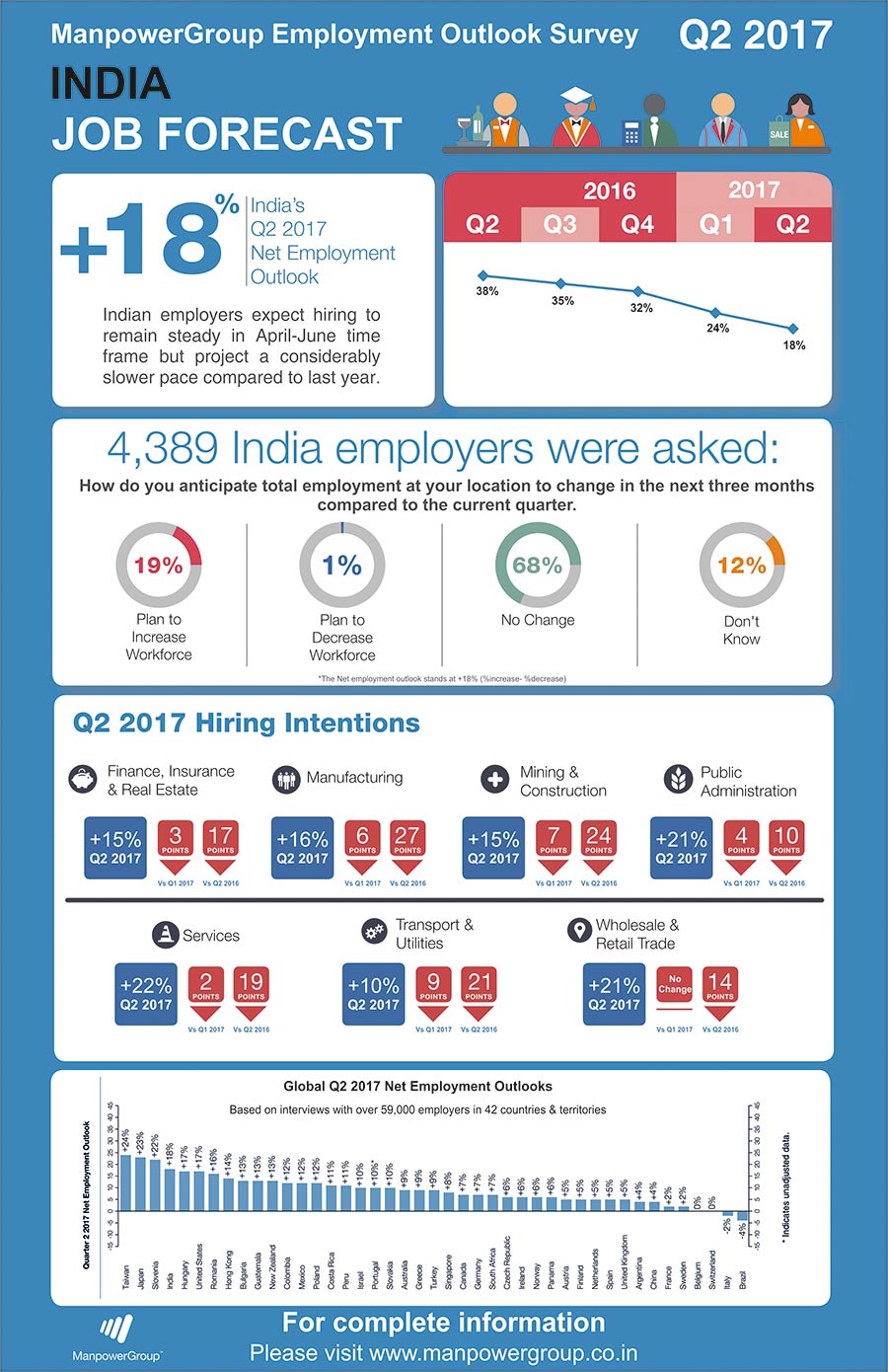
Employment outlook for April-June 2017 weakens
A sluggish global economy and technological disruption threaten job creation in the second quarter of the calendar year, for which hiring intention is expected to be at its weakest since July-September 2005

India Inc. will continue hiring new talent in the second quarter of calendar year 2017, but its hiring intention is at its weakest in over 11 years, according to a recent survey.
The India Employment Outlook survey, prepared by the ManpowerGroup, that was released on Tuesday estimates seasonally adjusted net employment outlook at 18 percent for the April-June 2017 period. The net employment outlook figure is derived by taking the percentage of employers anticipating total employment to increase and subtracting from this the percentage expecting to see a decrease in employment at their location in the next quarter.
The ManpowerGroup prepared the quarterly survey by interviewing a representative sample of 4,839 employers across India and asking them: “How do you anticipate total employment at your location to change in the three months to the end of June 2017 as compared to the current quarter?”
For the three months ending June 2017 (which will also be the first quarter of fiscal 2017-18), 19 percent of those surveyed said they expected hiring activity to increase, while 1 percent expected a decrease. Another 68 percent of the respondents felt there would be no chance in the overall employee base, while the remaining said they didn’t know.
The situation is starkly different from the optimism recorded by the outlook survey for the same quarter last year (2016), when 48 percent of the respondents said there would an increase in total employment at their organisations, and only 9 percent felt there would a decrease.
Some of the reasons for the declining perception of total hiring in the second quarter of 2017 are an overall sluggish global economy and the threat of new-age digital services such as automation and artificial intelligence reducing dependence on human jobs.
“The hiring outlook will move at a slow but steady pace as Indian companies gauge the impact of the ongoing global slowdown compounded by automation in the IT sector and talent scarcity for niche skills,” says AG Rao, group managing director of ManpowerGroup India. “However, there will be great demand for high- skill jobs for the new positions created by automation. The government is putting efforts towards creating jobs and making India a manufacturing hub. Budget 2017 is further expected to favour more foreign investments in India and initiatives like 'Make in India' should drive global companies to set-up manufacturing facilities in India.”
While initiatives like Make in India have been well-received by the industry, the plans that will lead to a capital expenditure cycle and large-scale job creation are still being put in place, and the impact is yet to be felt on the ground.
Rao stated that, in the current context, it was imperative for job seekers to “up-skill and diversify into new areas,” as technology was driving innovation. This is evident from the disproportionate emphasis that most Indian information technology (IT) companies, including large recruiters like Infosys, Tata Consultancy Services and Cognizant, are laying on digital tools such as cloud computing, artificial intelligence and machine learning, bots and automation.
The winds of change blowing in India’s IT sector from a technological perspective, is also coupled with political developments in the US, which may lead to uncertainty of the business model on which the industry was founded—essentially of winning outsourced mandates from the world’s largest companies to run their enterprise applications and offering them a cost arbitrage in the process. The new US President Donald Trump’s keenness to retain jobs within the US and clamp down on such outsourcing activity by American companies by bringing in stringent visa norms is expected to lead to operational challenges for Indian IT majors, who have been lobbying with the US government to soften the impact of any potential blow to them.
Consequently, the services sector is expected to see the weakest labour market in eight years in the June quarter with a net employment outlook of 22 percent, a 19 percentage points decline over the year-ago period.
The growth story of the Indian startup sector also appears to be faltering as several of these new-age companies are finding it difficult to sustain their expansion till date and raise fresh funds at existing valuations. Coupled with lack of profitability and high rates of cash burn, these ventures have been forced to either shut shop or scale down operations by laying off people. The recent and most high-profile example of this phenomenon was India’s online marketplace Snapdeal, which was reported to have laid off as many as 600 employees in February 2017. Another prominent Indian startup, homestay network Stayzilla has also suspended all operations and handed pink slips to employees.
The net employment outlook across other sectors such as finance, insurance and real estate; manufacturing; mining and construction; public administration and education; transport and utilities; and wholesale and retail trade has also weakened, though hiring is expected to continue in each of these segments.

X




